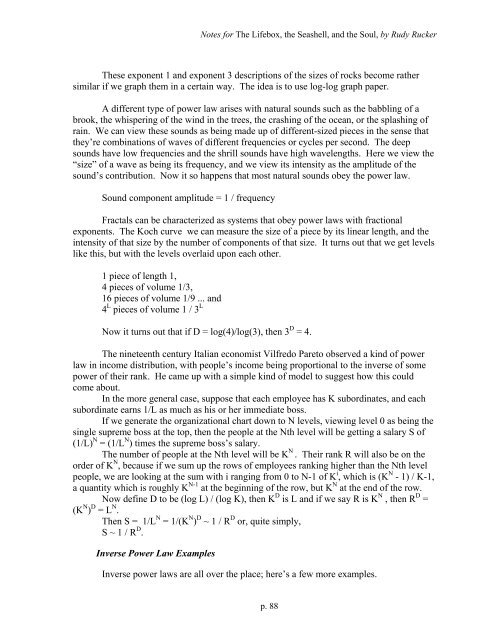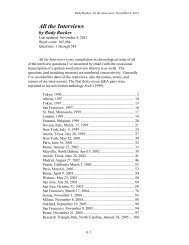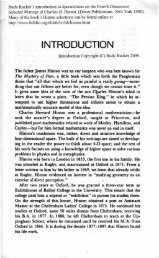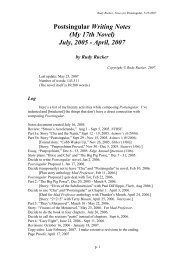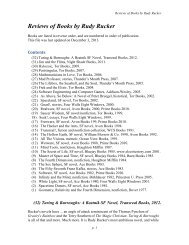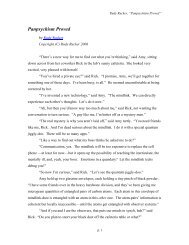Notes for the Lifebox, the Seashell, and the Soul - Rudy Rucker
Notes for the Lifebox, the Seashell, and the Soul - Rudy Rucker
Notes for the Lifebox, the Seashell, and the Soul - Rudy Rucker
You also want an ePaper? Increase the reach of your titles
YUMPU automatically turns print PDFs into web optimized ePapers that Google loves.
<strong>Notes</strong> <strong>for</strong> The <strong>Lifebox</strong>, <strong>the</strong> <strong>Seashell</strong>, <strong>and</strong> <strong>the</strong> <strong>Soul</strong>, by <strong>Rudy</strong> <strong>Rucker</strong><br />
These exponent 1 <strong>and</strong> exponent 3 descriptions of <strong>the</strong> sizes of rocks become ra<strong>the</strong>r<br />
similar if we graph <strong>the</strong>m in a certain way. The idea is to use log-log graph paper.<br />
A different type of power law arises with natural sounds such as <strong>the</strong> babbling of a<br />
brook, <strong>the</strong> whispering of <strong>the</strong> wind in <strong>the</strong> trees, <strong>the</strong> crashing of <strong>the</strong> ocean, or <strong>the</strong> splashing of<br />
rain. We can view <strong>the</strong>se sounds as being made up of different-sized pieces in <strong>the</strong> sense that<br />
<strong>the</strong>y’re combinations of waves of different frequencies or cycles per second. The deep<br />
sounds have low frequencies <strong>and</strong> <strong>the</strong> shrill sounds have high wavelengths. Here we view <strong>the</strong><br />
“size” of a wave as being its frequency, <strong>and</strong> we view its intensity as <strong>the</strong> amplitude of <strong>the</strong><br />
sound’s contribution. Now it so happens that most natural sounds obey <strong>the</strong> power law.<br />
Sound component amplitude = 1 / frequency<br />
Fractals can be characterized as systems that obey power laws with fractional<br />
exponents. The Koch curve we can measure <strong>the</strong> size of a piece by its linear length, <strong>and</strong> <strong>the</strong><br />
intensity of that size by <strong>the</strong> number of components of that size. It turns out that we get levels<br />
like this, but with <strong>the</strong> levels overlaid upon each o<strong>the</strong>r.<br />
1 piece of length 1,<br />
4 pieces of volume 1/3,<br />
16 pieces of volume 1/9 ... <strong>and</strong><br />
4 L pieces of volume 1 / 3 L<br />
Now it turns out that if D = log(4)/log(3), <strong>the</strong>n 3 D = 4.<br />
The nineteenth century Italian economist Vilfredo Pareto observed a kind of power<br />
law in income distribution, with people’s income being proportional to <strong>the</strong> inverse of some<br />
power of <strong>the</strong>ir rank. He came up with a simple kind of model to suggest how this could<br />
come about.<br />
In <strong>the</strong> more general case, suppose that each employee has K subordinates, <strong>and</strong> each<br />
subordinate earns 1/L as much as his or her immediate boss.<br />
If we generate <strong>the</strong> organizational chart down to N levels, viewing level 0 as being <strong>the</strong><br />
single supreme boss at <strong>the</strong> top, <strong>the</strong>n <strong>the</strong> people at <strong>the</strong> Nth level will be getting a salary S of<br />
(1/L) N = (1/L N ) times <strong>the</strong> supreme boss’s salary.<br />
The number of people at <strong>the</strong> Nth level will be K N . Their rank R will also be on <strong>the</strong><br />
order of K N , because if we sum up <strong>the</strong> rows of employees ranking higher than <strong>the</strong> Nth level<br />
people, we are looking at <strong>the</strong> sum with i ranging from 0 to N-1 of K i , which is (K N - 1) / K-1,<br />
a quantity which is roughly K N-1 at <strong>the</strong> beginning of <strong>the</strong> row, but K N at <strong>the</strong> end of <strong>the</strong> row.<br />
Now define D to be (log L) / (log K), <strong>the</strong>n K D is L <strong>and</strong> if we say R is K N , <strong>the</strong>n R D =<br />
(K N ) D = L N .<br />
Then S = 1/L N = 1/(K N ) D ~ 1 / R D or, quite simply,<br />
S ~ 1 / R D .<br />
Inverse Power Law Examples<br />
Inverse power laws are all over <strong>the</strong> place; here’s a few more examples.<br />
p. 88


